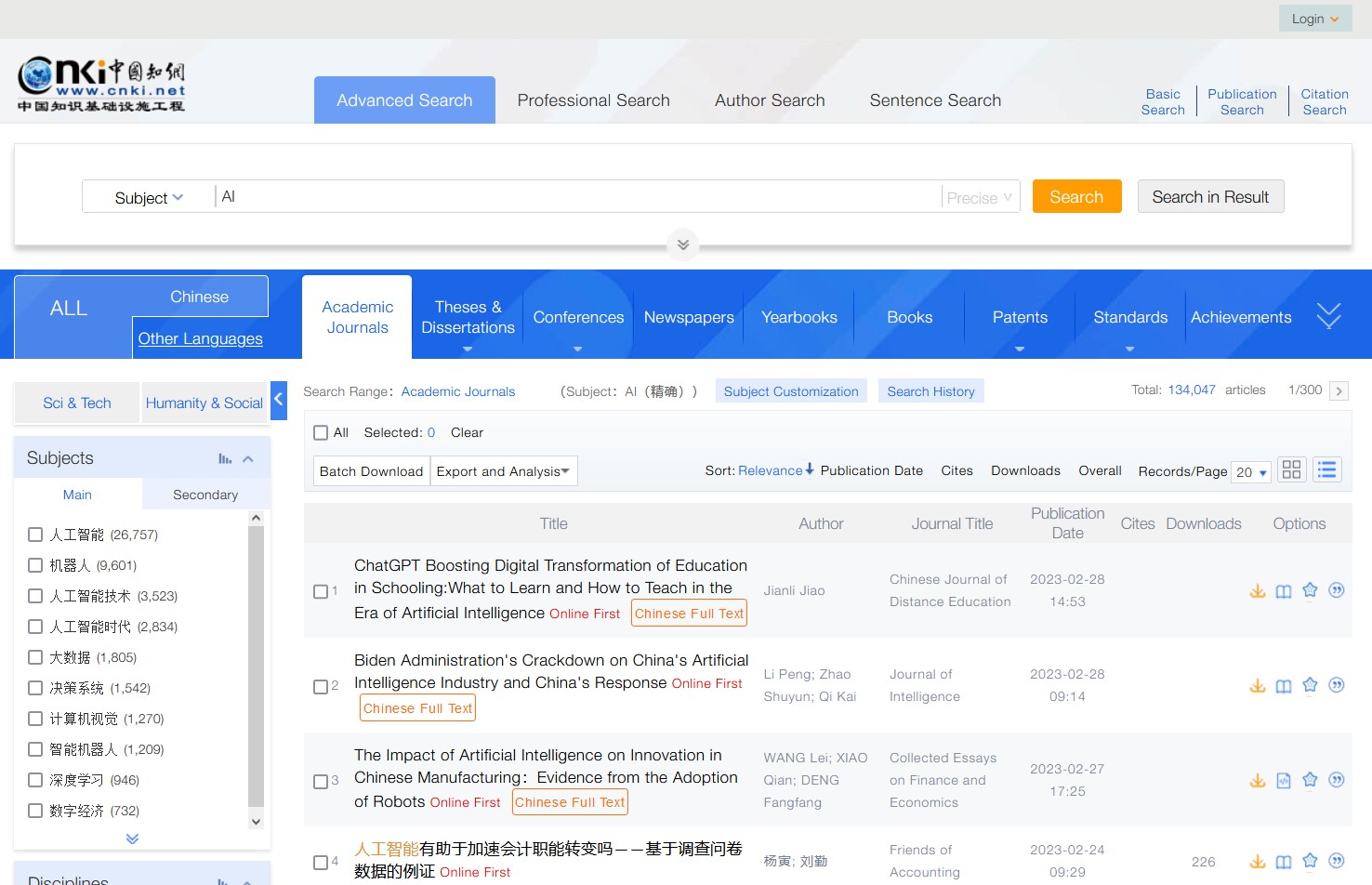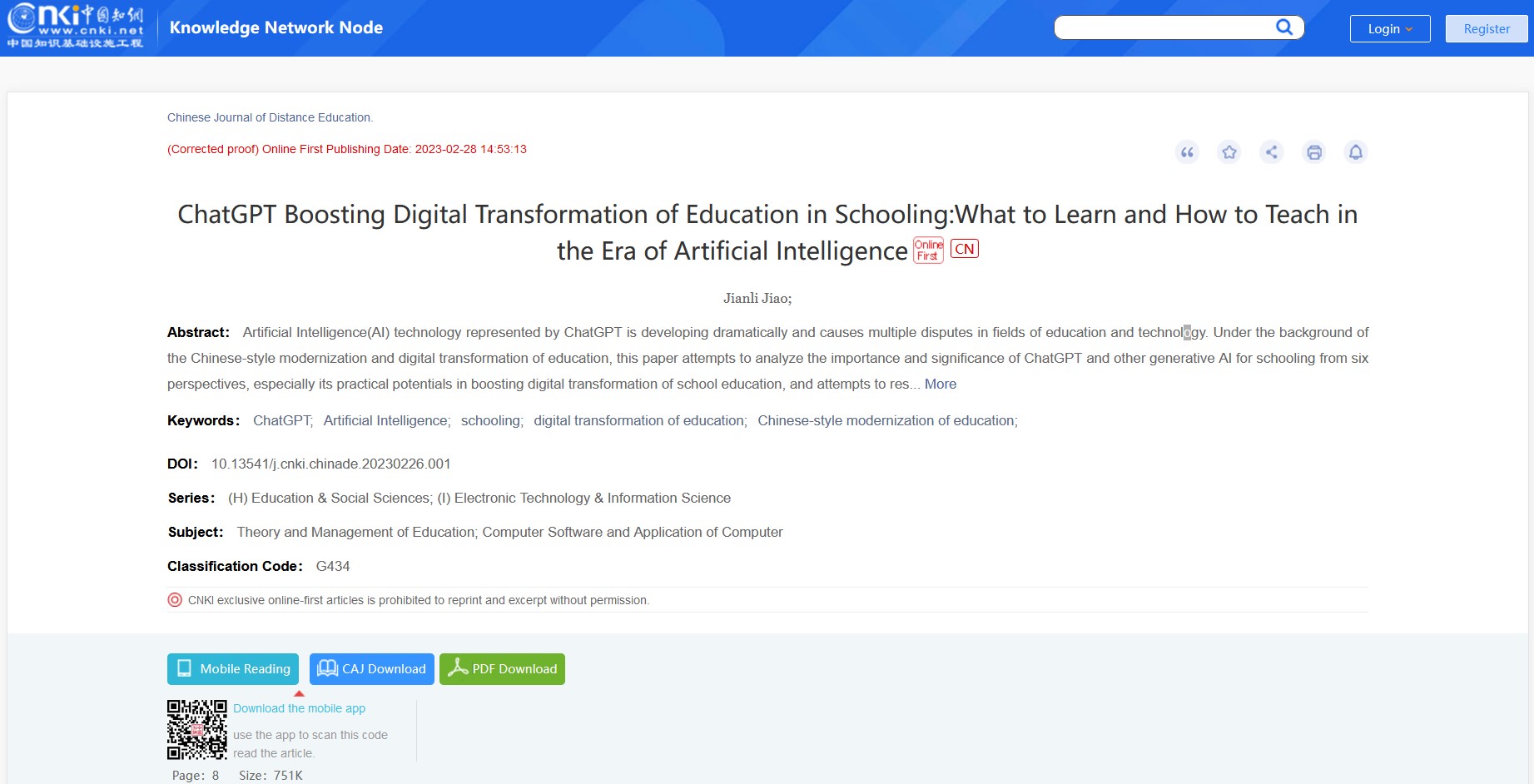China Academic Journals
中国期刊全文数据库; 中国学术期刊网络出版总库
KNS Main 8.0
China Academic Journals (CAJ) is comprised of academic journals from all disciplines of scholarship. In total, CAJ presents over 10,000 titles. The database is organized by subject disciplines, as follows:
A: Mathematics, Physics, Mechanics, Astronomy
B: Chemistry, Metallurgy, Environment, Mining
C: Architecture, Energy, Traffic, Electromechanics
D: Agriculture
E: Medicine and Public Health
F: Literature, History, Philosophy
G: Politics, Military Affairs, Law
H: Education and Social Science
I: Electronic Technology and Information Science
J: Economics and Management
All journals are cross-searchable in the database. The majority of journals are in the Chinese language, though most articles include bilingual English/Chinese titles and abstracts. All journals are fully searchable (including the table of contents, index, footnotes, article text, and citations).
Main Page Features
The main page of CAJ gives you search options including Basic Search and Advanced Search, which can be accessed from the main search bar at the top of the screen. Users can also browse titles, by clicking on the “Journal Navigation” button. The lower half of the main screen features links to content that is not limited to CAJ, but includes content from many other databases on the CNKI platform. Content here is featured as “Recommended” or “Popular” based on frequency of citation and use across the database, and the feature labelled as “Literatures” is intended to facilitate browsing by document type (e.g. journal articles, theses and dissertations, patents, standards, reference articles, etc.). To the right, the column labelled “Publication” presents a variety of suggested publications.

Content Navigation
By clicking on “Journal Navigation,” the user is presented with a new window. The left side of the screen presents CNKI subject series A-J (and by moving the mouse over this menu, the sub-categories within each). Users can also filter to only browse certain categories of journals, such as Academic, Online First, Exclusive or those journals with pre-1994 content included in the Century Journals Project. Users can also search for specific journals according to the Chinese/English title, publishing sponsor, ISSN or domestic CN number. By clicking on the thumbnail image of the journal cover, users are presented with the journal information page. At the top is the basic information on the journal, including possible former title, publishing sponsor, periodicity, ISSN, domestic Chinese CN number, place of publication, language and publication start year. Users can also see CNKI specific publication information, such as the series and subject name, number of published articles, and downloads and citations. There is also presented evaluation information which covers impact factors, citation databases, and any honors awarded to the journal. Below the journal information, users can browse journal content by year and issue within the “Issue Browse”, as well as perform quick searches within the specific journal. The “Column Browse” provides users with the option to browse content by keywords. The option for “Statistics and Evaluation” lets users view graphical representations of the journal’s publishing trends in number of articles, funded research, discipline and keyword distribution, and more. Clicking on any article title presented within the issue will take users to the article details page with the option to download the full-text. Mousing over the article title gives users the option to directly download the PDF full-text, or view the online HTML version.

Search
CNKI provides users with a variety of search options geared to meet the user’s research needs. The simple search from the database main page allows users to begin research using key terms. Using the Advanced Search allows users to perform more refined search queries by specifying following search terms: subject, keyword, title, full text, author, the first author, corresponding author, author’s affiliation, fund, abstract, reference, CLC number and document source.

The database provides the following search options: subject, keyword, title, full text, author, the first author, corresponding author, author’s affiliation, fund, abstract, reference, CLC number, DOI, Journal Title, ISSN, and CN. See below for additional description of some of these search options.
(1) Subject search
Subject search allows users to search using CNKI-recommended subject fields. which contain all subjects of an article. CNKI uses professional dictionaries, subject term lists, bilingual dictionaries and other tools to help create a comprehensive list of all subjects covered by an article. Keyword truncation algorithms are used to exclude documents which have low or negligible correlation with searched subjects.
(2) Keyword search
Searchable keywords include those Chinese and English keywords provided within the original text of the document, as well as keywords recommended by CNKI following analysis and indexing of the document. The keywords recommended by CNKI are based on the analysis of the full text combined with professional dictionaries, which augment the sometimes incomplete and imprecise keywords provided by authors in the published document.
(3) Title search
The titles of journal articles are provided as published. This includes the article title in original Chinese, as well as an official English translation for many articles.
(4) Full text search
Full text search refers to the search within the full text of the documents, including the title, keywords, abstract, text and reference of the documents.
(5) Author search
The authors of journal articles are often provided and searchable in both Chinese and transliteration.
(6) The first author search
When there is only one author in an article, the author is the first author. When there are several authors in an article, the author ranking first is identified as the first responsible person for the article.
(7) Corresponding author search
At present, the corresponding authors of the original text of journal documents are indexed, and can be used to search the journal documents. Corresponding authors are the chief heads of a project and the contact persons for articles and research materials.
(8) Author’s affiliation search
The affiliation of the authors is the name of the authors’ organization given by the original text. This is often the author’s degree-awarding affiliation or place of employment as referenced by the original text.
(9) Fund search
The documents supported by certain funding can be searched according to the official name of the fund.
(10) Abstract search
A large percentage of articles include an original Chinese and English abstracts in the original text. If the original text does not include an abstract, part of the text is extracted in place of an abstract.
(11) References search
Users can search within the references of a document for specific terms.
(12) CLC number search
All documents can be searched according to their Chinese Library Classification (CLC) number.
(13) CN
Documents can be searched according to the Journal’s domestic Chinese registration number
Tabs at the top of the page allow users to choose between different search interfaces: Advanced, Professional, Author and Sentence. Advanced Search allows users to create complex search queries using the provided search fields. Precise search will search the terms exactly as entered within the search box, and Fuzzy will search for any combination of the terms within the article. Based upon user’s entered search term(s), the platform will provide recommended search terms.
Search Results
Search results are presented underneath the search interface (which collapses once query is complete and can be expanded to further refine previous searches). Users can view the total number of articles included in the search results, set the number of records displayed on the page, and choose between list and detail view. Search results can be sorted by subject, publication date, number of cites and number of downloads. The search results are presented in columns displaying the title, author, source journal title, publication date, number of cites and downloads, and options to download full-text, copy the link, recommend or download the article citation in a variety of different formats (EndNote, NoteExpress, RefWorks, MLA, APA and more). By clicking on a title, a new window opens which displays the detailed article page. From the search results, users can also select articles and export the citations, as well as create visual graphics depicting the search results based on analysis and distribution of data such as publication date, subject, source, fund and author.

Article Page
Article pages are accessible by clicking on search result titles. The top of the article page includes journal information, table of contents, title, author(s), abstract, keywords, fund, CNKI series, and subjects. From the article page, users can download in HTML or PDF formats. Below download formats are subject and citation network maps and references. If images from the publication are available through enhanced publishing, they will appear on the left, below the table of contents.

Accessing Full Text
Full-text can be downloaded at different stages through the database. Users can download full-text from the table of contents found within the Journal Navigation, as well as the search results display. A blue arrow indicates the article is available to download as part of the institution’s account access. An orange arrow indicates the full-text is outside a user’s subscribed access. From the Brief Results Page, users have the option to download the full-text as PDF, as well as view the article in HTML.
FAQ
Why do I see citation information from non-Chinese publications?
CNKI has integrated the bibliographic and citation data from more than 700 international publishing houses, covering 94% of JCR journals and 90% of Scopus journals, as well as a large number of books, conference proceedings, patents, statistical data and reference materials, with a total of more than 300 million entries. This provides users with a unified discovery platform for Chinese and non-Chinese content. Users can view bibliographic and abstract data for non-CNKI content, and are provided a link to the source website where users can pursue the full-text. To limit results to CNKI’s content, click “Chinese.”
When I download the PDF full-text, I only see a blank page and some numbers?
There is a limited amount of content in CNKI where the original files have been created by the publisher in PDF without the fonts embedded in the file. In order to view the text, please download the Extended East Asian Fonts pack for Adobe from the Adobe website. Please note that you may need Administrator rights in order to install this font pack onto your pc, depending upon institutional regulations.